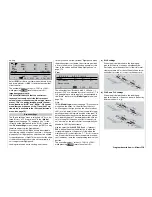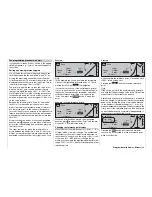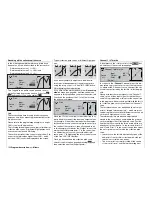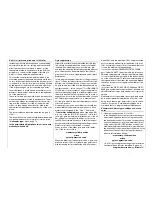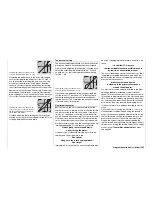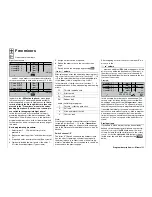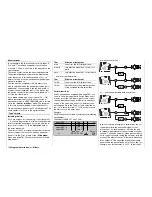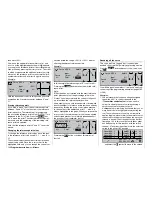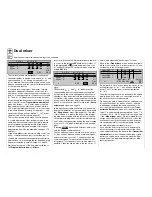
131
131
Program description:
Mixers
Now bring the model back to the hover, which again
should coincide with the mid-point of the C1 stick. If
you fi nd that the collective pitch stick now has to be
moved from the mid-point in the “higher” direction,
then you should correct this deviation by increasing
the collective pitch angle at the hover until the model
again hovers at stick centre. Conversely, if the model
hovers below the mid-point, correct this by reducing
pitch angle again. You may fi nd that it is also necessa-
ry to correct the throttle opening at the hover point.
Continue adjusting these settings until you really do
achieve a constant rotational speed over the full cont-
rol range between hover and climb.
OUTPUT
–
+
L
H
Control travel
Hover point
This diagram shows the changes to the
collective pitch maximum value “H” only.
OUTPUT
–
+
L
H
Control travel
Hover point
This diagram shows the change to the
hover point only, i.e. collective pitch mi-
nimum and maximum have both been
left at -100% and +100%.
The descent setting
The descent adjustment should now be carried out by
placing the model in a steady descent from forward
fl ight at a safe height by fully reducing collective pitch;
adjust the collective pitch minimum value (“Collecti-
ve pitch low”) so that the model descends at an ang-
le of 60 … 80°.
Once the model descends reliably as described, ad-
just the value for “Throttle low (L)” so that system ro-
tational speed neither increases nor diminishes du-
ring the descent. This completes the set-up procedure
for throttle and collective pitch.
Final important notes
Before you start the motor, check carefully that the
throttle limiter is completely closed, so that the throttle
can be controlled by the trim lever alone. If the thrott-
le is too far open when you switch on the transmitter,
you will see and hear a warning. If you ignore this and
start the motor with the throttle too far advanced, the-
re is a danger that the motor will run up to speed wit-
hout delay after starting, and the centrifugal clutch will
immediately engage. For this reason you should:
Always grasp the rotor head fi rmly
when starting the motor.
However, if you accidentally start the motor with the
throttle open, the golden rule is this:
Don’t panic!
Hang on to the rotor head regardless!
Don’t let go!
Immediately close the throttle, even though there may
be a risk of damaging the helicopter’s drive train, be-
cause:
it is vital that YOU ensure
that the helicopter cannot possibly move off
by itself in an uncontrolled manner.
The cost of repairing a clutch or even the motor itself
is negligible compared with the damage which a mo-
del helicopter can cause if its spinning rotor blades
are allowed to wreak havoc.
Make sure that nobody else
is standing in the primary hazard zone
around the helicopter.
You must never switch abruptly from idle to the fl ight
setting by suddenly increasing system rotational
speed. This causes the rotor to accelerate very quick-
ly, resulting in premature wear of the clutch and gear
train. The main rotor blades are generally free to swi-
vel, and they often cannot keep pace with such swift
acceleration; they may respond by swinging far out
of their normal position, perhaps resulting in a boom
strike.
Once the motor is running you should s l o w l y in-
crease system rotational speed using the
throttle li-
miter
; if you have assigned an external switch for the
throttle limiter, we strongly recommend that you pro-
gram a time constant of about fi ve seconds for run-
ning up the system rotational speed (opening the
throttle limiter), although there should always be zero
time delay for closing the throttle limiter. These values
are set in the »
Transmitter control adjust
« menu;
see page 80.
This diagram shows the changes to the
collective pitch minimum value “L” only.
OUTPUT
–
+
L
H
Control travel
Hover point
Summary of Contents for mx-24s
Page 1: ...1...
Page 19: ...19 For your notes...
Page 35: ...35 For your notes...
Page 41: ...41 41 For your notes...
Page 57: ...57 For your notes...
Page 63: ...63 63 For your notes...
Page 69: ...69 69 For your notes...
Page 85: ...85 85 For your notes...
Page 99: ...99 For your notes...
Page 143: ...143 For your notes...
Page 191: ...191 For your notes...
Page 212: ...212 212 For your notes...
Page 213: ...213 213 For your notes...
Page 214: ...214 For your notes...
Page 216: ...216...



